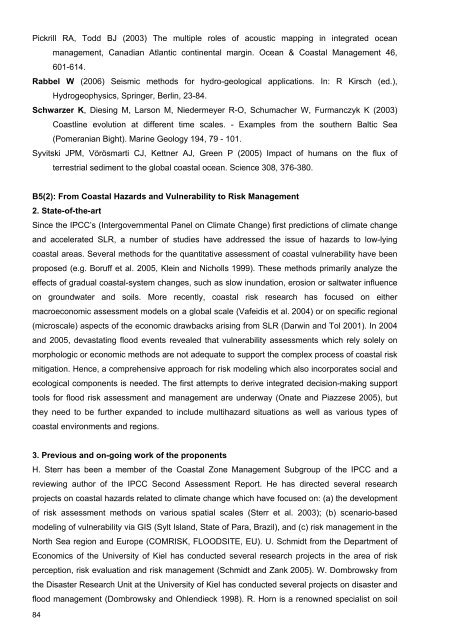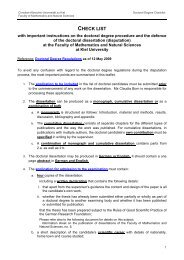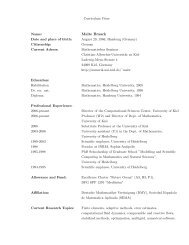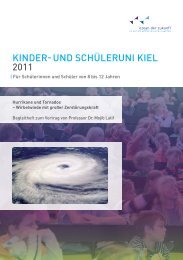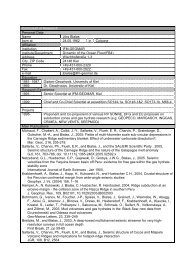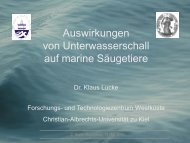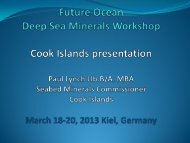column, as well as sedimentary structures on and beneath the seafloor. Parallel to data acquisitionat sea, seismic and georadar measurements will be carried out on land for comprehensivereconstructions of shoreline change. <strong>The</strong>se combined results will provide the input necessary forthe development of multidisciplinary strategies for coastal risk assessment and will form the basisfor numerical model development.An improved understanding of the dynamics which control near-shore sediment budgets duringsea-level fluctuations is required to accurately assess future coastal evolution. Data concerningthese processes on variable timescales are needed to assess the conditions which trigger coastalhazards. By considering various scenarios for climate change and human intervention which affectSLR and shoreline migration, the following key and interrelated topics will be addressed in aninnovative change analysis approach: (1) changes in near-shore slope gradients; (2) changes innear-shore circulation systems; (3) impacts on the coastal sediment budget, including rates of andbalances between erosion and sedimentation; (4) effects on biological and ecological systems; and(5) disturbances of coastal infrastructures.Principal research targets are primarily changing river-mouth systems, in particular: (1) thetransition from deltaic to estuarine systems; (2) shoreline changes ranging from prograding toretrograding; (3) inland migration of the groundwater/saltwater interface which leads to the pollutionof freshwater resources; and (4) the consequences of sand/gravel extraction and waste dumping.In addition to direct connections with B5(2), B5(1) will have close ties to A4 (climate change), B1(nursery habitats in the coastal zone), B4 (impacts of deep-sea hazards) and B6 (juridicaldefinitions of offshore economic zones). Research platforms P1, P2 and P4 will be usedextensively.5. ReferencesCaldas LH, Stattegger K, Vital H (2006) Holocene sea-level history: Evidence from coastalsediments of the northern Rio Grande do Norte coast, NE Brazil. Marine Geology 228, 39-53.Church JA, White NJ (2006) A 20th century acceleration in global sea-level rise. GeophysicalResearch Letters 33, L01602, doi:10.1029/2005GL024826.Crossland JC, Kremer HH, Lindeboom HJ, Marshall Crossland JI, Le Tissier MD (2005) CoastalFluxes in the Anthropocene. Global Change – <strong>The</strong> IGBP Series, 232 pp., Springer.Diesing M, Kubicki A, Winter C, Schwarzer K (in press) Decadal scale stability of sorted bedforms,German Bight, southeastern North Sea. Continental Shelf Research.Ericson JP, Vörösmarty CJ, Dingman SL, Ward LG, Meybeck M (2006) Effective sea-level rise anddeltas: Causes of change and human dimension implications. Global and Planetary Change50, 63-82.Hanebuth T, Stattegger K, Grootes P (2000) Rapid flooding of the Sunda Shelf - a late glacialsea-level record. Science 288, 1033-1035.Overpeck JT, Otto-Bliesner BL, Miller GH, Muhs DR, Alley RB, Kiehl JT (2006) Paleoclimaticevidence for future ice-sheet instability and rapid sea-level rise. Science 311, 1747-1750.83
Pickrill RA, Todd BJ (2003) <strong>The</strong> multiple roles of acoustic mapping in integrated oceanmanagement, Canadian Atlantic continental margin. <strong>Ocean</strong> & Coastal Management 46,601-614.Rabbel W (2006) Seismic methods for hydro-geological applications. In: R Kirsch (ed.),Hydrogeophysics, Springer, Berlin, 23-84.Schwarzer K, Diesing M, Larson M, Niedermeyer R-O, Schumacher W, Furmanczyk K (2003)Coastline evolution at different time scales. - Examples from the southern Baltic Sea(Pomeranian Bight). Marine Geology 194, 79 - 101.Syvitski JPM, Vörösmarti CJ, Kettner AJ, Green P (2005) Impact of humans on the flux ofterrestrial sediment to the global coastal ocean. Science 308, 376-380.B5(2): From Coastal Hazards and Vulnerability to Risk Management2. State-of-the-artSince the IPCC’s (Intergovernmental Panel on Climate Change) first predictions of climate changeand accelerated SLR, a number of studies have addressed the issue of hazards to low-lyingcoastal areas. Several methods for the quantitative assessment of coastal vulnerability have beenproposed (e.g. Boruff et al. 2005, Klein and Nicholls 1999). <strong>The</strong>se methods primarily analyze theeffects of gradual coastal-system changes, such as slow inundation, erosion or saltwater influenceon groundwater and soils. More recently, coastal risk research has focused on eithermacroeconomic assessment models on a global scale (Vafeidis et al. 2004) or on specific regional(microscale) aspects of the economic drawbacks arising from SLR (Darwin and Tol 2001). In 2004and 2005, devastating flood events revealed that vulnerability assessments which rely solely onmorphologic or economic methods are not adequate to support the complex process of coastal riskmitigation. Hence, a comprehensive approach for risk modeling which also incorporates social andecological components is needed. <strong>The</strong> first attempts to derive integrated decision-making supporttools for flood risk assessment and management are underway (Onate and Piazzese 2005), butthey need to be further expanded to include multihazard situations as well as various types ofcoastal environments and regions.3. Previous and on-going work of the proponentsH. Sterr has been a member of the Coastal Zone Management Subgroup of the IPCC and areviewing author of the IPCC Second Assessment Report. He has directed several researchprojects on coastal hazards related to climate change which have focused on: (a) the developmentof risk assessment methods on various spatial scales (Sterr et al. 2003); (b) scenario-basedmodeling of vulnerability via GIS (Sylt Island, State of Para, Brazil), and (c) risk management in theNorth Sea region and Europe (COMRISK, FLOODSITE, EU). U. Schmidt from the Department ofEconomics of the University of Kiel has conducted several research projects in the area of riskperception, risk evaluation and risk management (Schmidt and Zank 2005). W. Dombrowsky fromthe Disaster Research Unit at the University of Kiel has conducted several projects on disaster andflood management (Dombrowsky and Ohlendieck 1998). R. Horn is a renowned specialist on soil84
- Page 7 and 8:
Contents1 General Information about
- Page 9 and 10:
1 General Information about the Clu
- Page 11 and 12:
1.2 Research Program1.2.1 Summary/Z
- Page 13 and 14:
1.2.2.2 ObjectivesThe Future Ocean
- Page 15 and 16:
will address the emerging new resea
- Page 17 and 18:
Topics Objectives DisciplinesA1 Exa
- Page 19 and 20:
development of these new initiative
- Page 21 and 22:
Project Objective IndustryPartnersO
- Page 23 and 24:
Continued excellence in the field o
- Page 25 and 26:
The establishment of several new po
- Page 27 and 28:
1.4.1 Integrated School of Ocean Sc
- Page 29 and 30:
ensure that emerging innovations wi
- Page 31 and 32:
Institute / DisciplineAcademic Leve
- Page 33 and 34:
their orientation according to the
- Page 35 and 36:
1.7.2 Structural Evolution and Qual
- Page 37 and 38:
30- Notes -
- Page 39 and 40: organisms to elevated CO 2 and decr
- Page 41 and 42: ist wahrscheinlich stärker als wä
- Page 43 and 44: out by the proponents and will esta
- Page 45 and 46: Rückkopplungsschleife weitere Erw
- Page 47 and 48: enthic biota of gas release or the
- Page 49 and 50: Synthese, aufbauend auf einer Kombi
- Page 51 and 52: (4) a determination of the impact o
- Page 53 and 54: Einflüsse. Um deren Auswirkungen b
- Page 55 and 56: on longer time scales. The latter t
- Page 57 and 58: werden kann. Allerdings sind die ch
- Page 59 and 60: the expertise which already exists
- Page 61 and 62: 2. State-of-the-artThe changing com
- Page 63 and 64: • Field and laboratory investigat
- Page 65 and 66: Erwärmung der Ozeane kann zur Frei
- Page 67 and 68: Valuing the Ocean: Research focus a
- Page 69 and 70: submarine earthquakes, slumps and s
- Page 71 and 72: Fischerei ist eine der wichtigsten
- Page 73 and 74: ecosystems. In particular, the foll
- Page 75 and 76: Hochdurchsatztechnologien die Evolu
- Page 77 and 78: microbial diversity on their barrie
- Page 79 and 80: transient three-dimensional fluid f
- Page 81 and 82: modeling, which describe chemical a
- Page 83 and 84: Erdbeben, submarine Hangrutschungen
- Page 85 and 86: Simons 2003) to investigate shallow
- Page 87 and 88: damit zusammenhängender Meeresspie
- Page 89: B5(1) Sea-Level Rise and Physical-M
- Page 93 and 94: Onate E, Piazzese J (2005) Decision
- Page 95 and 96: echtlichen und ökonomischen Rahmen
- Page 97 and 98: marine resources, such as energy ex
- Page 99 and 100: 92- Notes -
- Page 101 and 102: 2. State-of-the-artThe variety of n
- Page 103 and 104: and will benefit from expertise in
- Page 105 and 106: Die Plattform 2 stellt die analytis
- Page 107 and 108: 4. New Cluster TechnologiesIn order
- Page 109 and 110: (iv) Proteomanalysetechniken und (v
- Page 111 and 112: 4. New Cluster TechnologiesA specia
- Page 113 and 114: Illustration of existing/emerging a
- Page 115 and 116: physical parameters (e.g. lowered a
- Page 117 and 118: etabliert, das insbesondere auf wis
- Page 119 and 120: 2.4.3.2 Central Funds for Transfer
- Page 121 and 122: International School of Ocean Scien
- Page 123 and 124: Description Year of purchase Amount
- Page 125 and 126: 3.2 Auxiliary Support3.2.1 Total Fu
- Page 127 and 128: 120- Notes -
- Page 129 and 130: Suess E, Torres ME, Bohrmann G, Col
- Page 131 and 132: Schreiber, StefanVisbeck, MartinSri
- Page 133 and 134: 4.3 Third-Party FundingNo. FundingB
- Page 135 and 136: Leibniz Institute of Marine Science
- Page 137 and 138: These JRG’s will augment the expe
- Page 139 and 140: The Cluster is embedded in the “K
- Page 141 and 142:
A14- Notes -
- Page 143 and 144:
4.6 Curricula Vitae and Lists of Pu
- Page 145 and 146:
Curriculum of ResearchPersonal Data
- Page 147 and 148:
Curriculum of ResearchPersonal Data
- Page 149 and 150:
Curriculum of ResearchPersonal Data
- Page 151 and 152:
Curriculum of ResearchPersonal Data
- Page 153 and 154:
Curriculum of ResearchPersonal Data
- Page 155 and 156:
Curriculum of ResearchPersonal Data
- Page 157 and 158:
Curriculum of ResearchPersonal Data
- Page 159 and 160:
Curriculum of ResearchPersonal Data
- Page 161 and 162:
Curriculum of ResearchPersonal Data
- Page 163 and 164:
Curriculum of ResearchPersonal Data
- Page 165 and 166:
Curriculum of ResearchPersonal Data
- Page 167 and 168:
Curriculum of ResearchPersonal Data
- Page 169 and 170:
Curriculum of ResearchPersonal Data
- Page 171 and 172:
Curriculum of ResearchPersonal Data
- Page 173 and 174:
Curriculum of ResearchPersonal Data
- Page 175 and 176:
Curriculum of ResearchPersonal Data
- Page 177 and 178:
Curriculum of ResearchPersonal Data
- Page 179 and 180:
Curriculum of ResearchPersonal Data
- Page 181 and 182:
Curriculum of ResearchPersonal Data
- Page 183 and 184:
Curriculum of ResearchPersonal Data
- Page 185 and 186:
Curriculum of ResearchPersonal Data
- Page 187 and 188:
Curriculum of ResearchPersonal Data
- Page 189 and 190:
Curriculum of ResearchPersonal Data
- Page 191 and 192:
Curriculum of ResearchPersonal Data
- Page 193 and 194:
Curriculum of ResearchPersonal Data
- Page 195 and 196:
Curriculum of ResearchPersonal Data
- Page 197 and 198:
Curriculum of ResearchPersonal Data
- Page 199 and 200:
Curriculum of ResearchPersonal Data
- Page 201 and 202:
Curriculum of ResearchPersonal Data
- Page 203 and 204:
Curriculum of ResearchPersonal Data
- Page 205 and 206:
Curriculum of ResearchPersonal Data
- Page 207 and 208:
Curriculum of ResearchPersonal Data
- Page 209 and 210:
A82- Notes -
- Page 211 and 212:
DEKLIMGerman Climate Research Progr
- Page 213 and 214:
ITQ’sISAISOSJRGKCMSKitzLALIFLIMSL
- Page 215 and 216:
WTOWTSHXAFSXRDZMBWorld Trade Organi
- Page 218:
Prof. Dr. Boris Culik • Maritimes
- Page 230:
GMT-Geschäf*sstelleWe"*w{eltJ"*n $
- Page 236:
f,rylheonRaytheon Anschütz GmbHPos


